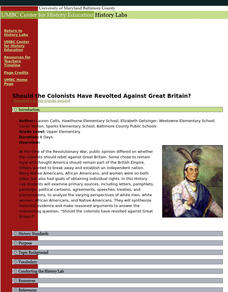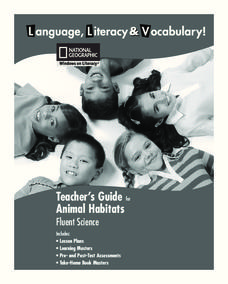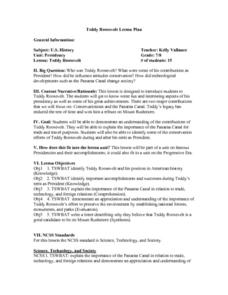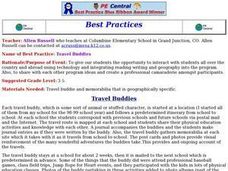PBS
Star Power
Let there be light—or maybe not. Pupils learn about light pollution with an investigation of constellations. They create constellation boxes and experiment with different levels of light. Observations are then made about the lighting in...
Center for History Education
Should the Colonists Have Revolted Against Great Britain?
Should the Americans have taken the plunge and revolted against Great Britain? Using documents, including the famed Common Sense and a Loyalist response, pupils conduct a lengthy investigation of the question. The interesting resource...
National Council for the Social Studies
Analyzing a Product or Political Advertisement
How do advertisements evoke specific thoughts and feelings? Class members find out through the exploration of the Internet, videos, television, magazines, radio, and posters. Learners investigate commercial advertisements, political...
Museum of Tolerance
Family Tree Activity
Discover the family histories that make the classroom with a family tree activity. Scholars locate information about their family, construct a family tree, and work together to tally where family members are born.
California Department of Education
An Online Tool I Can Use
Tools for school—and beyond! Introduce your sixth graders to online tools to plan their academic and professional futures. The fifth and final lesson in a series of career and college readiness activities focuses on a scavenger hunt to...
Brigham Young University
The Giver: Magic Squares
Combine math and vocabulary in a fun activity based on Lois Lowry's The Giver. Before kids begin the book, they look up the definitions of 16 vocabulary words and complete a puzzle that will give them the same number.
Alabama Department of Archives and History
Alabama's New South Era
The industrialization and urbanization of Alabama during the New South era (1865-1914) is the focus of a instructional activity that asks class members to use primary source documents to examine the impact of industrialization on Alabama...
Qrayon
Inkflow: Think Visually!
Save trees! Save graphite! Save ink! Go paperless! Make a list, mindmap, sketch an idea. Import, scale, rotate, and add text to images. Save content into books and share your creations. All this and more is yours with a free visual...
Curated OER
Queen Anne's War and Its Impact on Deerfield
Class members read a series of primary and secondary source materials to examine the effects of Queen Anne's War, also know as the War of Spanish Succession, on the Pocumtucks and other Native Americans in the area of Deerfield, MA.
English Worksheets Land
Blaze a Trail
Compare and contrast different ways that sources present information with a reading worksheet. After readers view two short passages about blazing a trail, they note the information they found in each selection.
National Geographic
Animal Habitats
Explore animal habitats and reinforce speaking, listening, reading comprehension, and writing skills with a unit that focuses on the Arctic, desert, ocean, prairie, and rainforest. Enthusiastic scientists read informational text to...
Chicago Botanic Garden
Reflecting on What I Learned About Climate Change
After three eye-opening lessons about our environment, scholars revisit a 10-question survey, reflect on their new-found knowledge, and take action by writing to a representative or creating a public service announcement about climate...
Curated OER
Don't Forget to Say Thanks
Learners practice descriptive writing in a thank-you note format. In this descriptive writing lesson, students read the example letter and analyze the corrections in the letter. Learners read the example thank you notes and focus on the...
Curated OER
Our Illuminated Alphabet TESTing
Students practice writing letters of the alphabet and explore how decorated letters can be used to convey stories or symbolic ideas. They create an "illuminated" alphabet in which each letter conveys concepts of home and family.
Curated OER
Teddy Roosevelt
Students examine the life, contributions, and influence of Teddy Roosevelt. They view a slideshow lecture and take notes on a handout, filling in the blanks on the handout. Students then write a persuasive letter to a governmental...
Curated OER
Sculptural Space
Students analyze the needs for outdoor sculpture and create their own example. In this sculpture instructional activity, students discuss the sculptural and architectural elements of site-specific sculpture. Students work in teams to...
Curated OER
Alphabetizing Words Beginning with R and S
Students alphabetize words that begin with R and S. In this alphabetizing instructional activity, students complete a worksheet in which they alphabetize words that end with R and S. After a classroom discussion about how to...
Curated OER
Presenting Your Case
Students research a famous person of their choice in this lesson. They research the person's life, feelings, and character through a series of written activities. They compile their research into a creative project called a character's...
Curated OER
Travel Buddies
A travel buddy is some sort of animal or stuffed character that is transported from one school to another and another. A journal accompanies the buddies and the students make journal entries as if they were written by the buddy at each...
Curated OER
Proper Nouns 6
In this noun usage worksheet, students find the proper noun in each list of three words and then print that word on the provided blank line.
Curated OER
Nouns
In this nouns worksheet, students fill in the blanks to sentences with a person, place, or thing. Students complete 10 problems total.
Curated OER
Subtracting Mixed Numbers
In this math worksheet, students subtract mixed numbers. Students find common denominators. They subtract the fractions and whole numbers.
Curated OER
Verbs in Past Tense
In this grammar worksheet, students fill in the correct form of the verb in parentheses in past tense in thirty sentences. Students check to make sure each one is grammatically correct.
Curated OER
Making Words
Third graders spell words and define homophone. In this making words lesson, 3rd graders decipher words from letter strips in an effort to identify the "secret word". Students use a set of letters to spell different words.

























